Asia-Pacific Sensors Market Size
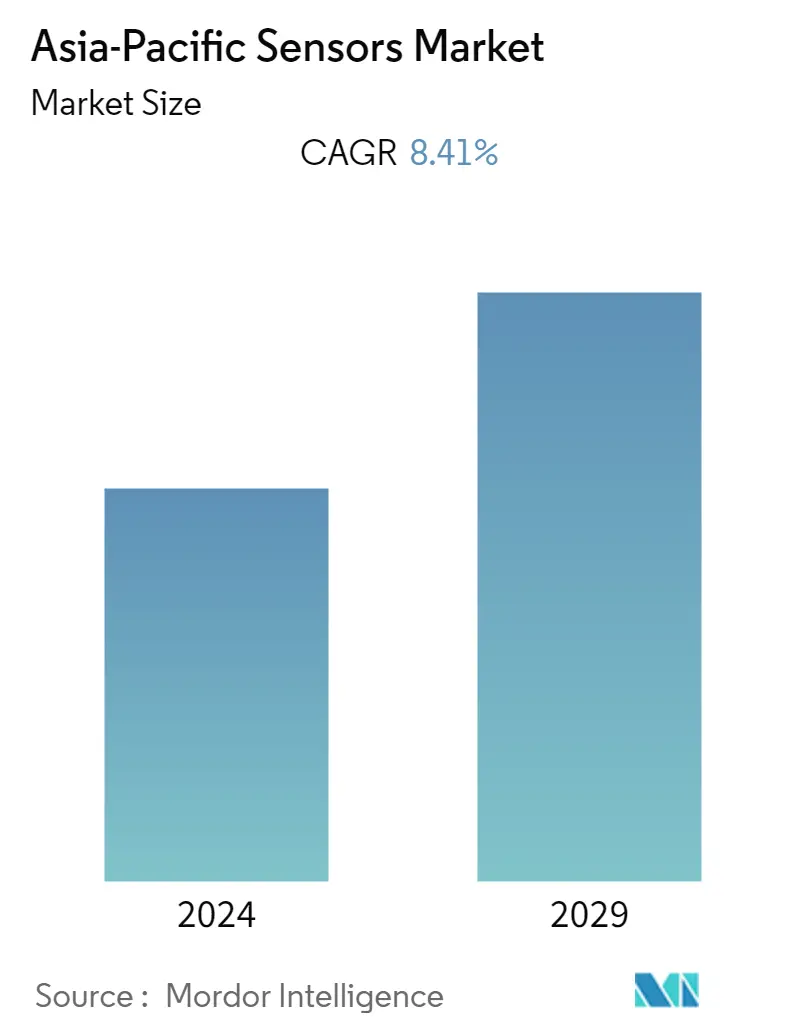
| Study Period | 2019 - 2029 |
| Base Year For Estimation | 2023 |
| Forecast Data Period | 2024 - 2029 |
| Historical Data Period | 2019 - 2022 |
| CAGR | 8.41 % |
| Market Concentration | Low |
Major Players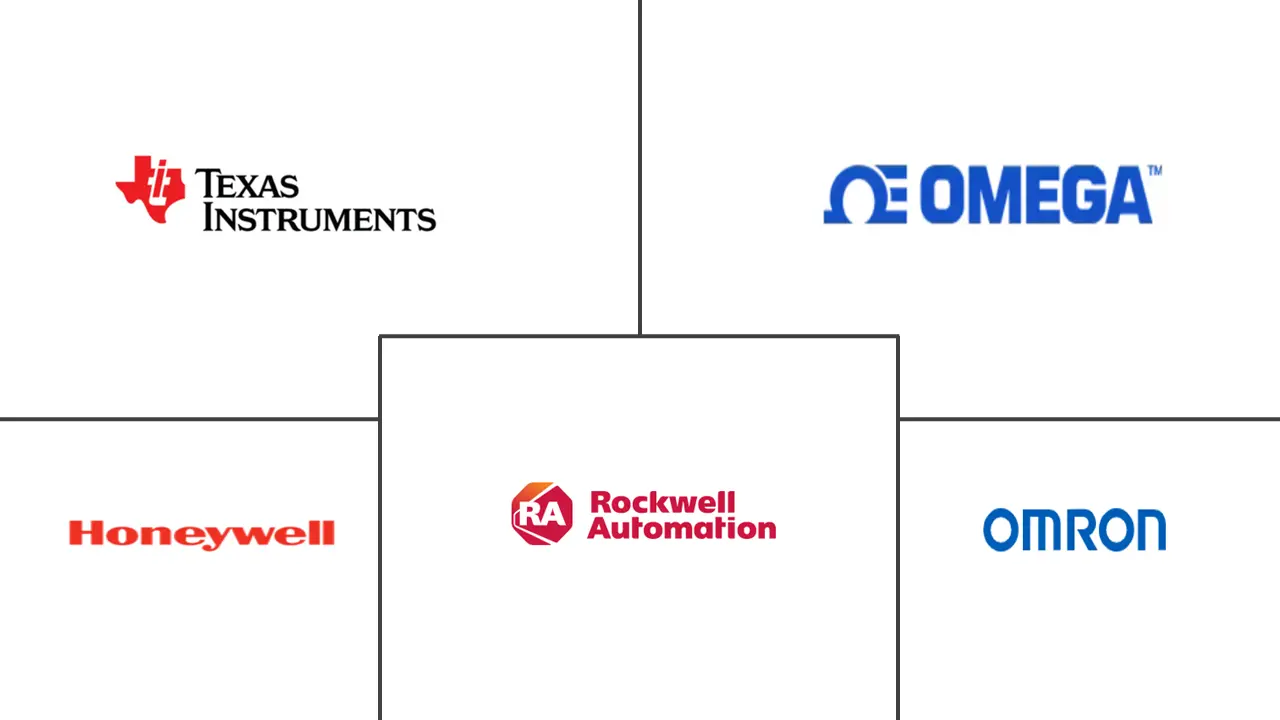
*Disclaimer: Major Players sorted in no particular order |
Asia-Pacific Sensors Market Analysis
The Asia-Pacific sensors market was valued at USD 47.84 billion in the current year and is expected to reach USD 75.90 billion by the end of the forecast period, registering a CAGR of 8.41% during the forecast period. Sensors are part of a broader system that gathers information about the outside environment, puts it in a comprehensible form, and then conveys it.
- Most sensors are produced in the APAC region, and sensor technology is extensively utilized worldwide since so many cutting-edge technologies depend on the functionality of the sensors. Electric grids, smart homes, and smartphones are just a few of its applications. In contrast to mature regions like North America, the APAC region is still developing and expanding its use of sensors due to the trend of smart devices, a smart environment, industry 4.0, and the Internet of Things.
- Due to the presence of significant consumer electronics manufacturers in this region, analysts predict that Asia-Pacific will dominate the sensors market. The market is anticipated to be driven by increasing smartphone penetration, 5G penetration, and advancements across numerous end-user industries. China, South Korea, Japan, and India, among others, are major Asia-Pacific countries.
- Moreover, the promise of smart cities has captivated the APAC region's technology industry. As per the recent report by Equinix, "Smart Cities: Shifting Asia", UBS projects that APAC will account for 40% of the global addressable market growth for smart city projects, or USD 800 billion by 2025. This rapid urbanization is driving IT buildout and interconnection bandwidth growth to sustain APAC's expanding digital market. As a result, smart city applications like smart grids and buildings, air and water monitoring, smart transportation, smart waste collection, and disaster response are likely to expand the opportunity areas for the sensor market.
- Although the integration of sensors increases the level of industrial automation, it incurs an additional cost, which limits its use in cost-sensitive applications. In addition, the high development costs involved in the research and development activities to manufacture new products act as a critical challenge, mainly for the cash-deficient small and medium-sized sensor manufacturers.
- The COVID-19 epidemic severely impacted the worldwide supply chain and demand for many items, making it challenging to obtain some resources. Additionally, several businesses experienced a supply deficit of different items in February and March 2020 as a result of the production halt in nations like China. The price of raw materials increased as a result of the supply chain disruption, which had an effect on the total pricing of the sensors because there wasn't enough supply to fulfill demand.
Asia-Pacific Sensors Market Trends
Consumer Electronics Industry is Expected to Hold a Significant Share
- The region's numerous consumer electronics manufacturing facilities account for the huge market growth. Global corporations that produce consumer electronics, including smartphones, have factories in China. Additionally, several smartphone manufacturing facilities in nations like India, Vietnam, Taiwan, and the Philippines also export their finished goods worldwide.
- Smartphones are one of the key products that employ several types of sensors. From the camera, display, and touch-up to distance and proximity measures, sensors have a wide range of usage for smartphones. As such, the growing adoption of smartphones is significantly propelling market growth.
- The use of image sensors for smartphones has been on the rise, and companies such as Sony and Samsung are the front runners in these markets. In July 2022, Sony announced the development of a new 100 MP CMOS sensor that will be seen on upcoming mid-range smartphones.
- In 2022, Samsung announced it was also working on a 200 MP sensor, confirmed to work with the Motorola Frontier. Samsung is also actively involved in developing smartphone camera sensors with a higher pixel range. Such innovations and developments in the image sensor markets have contributed to the growth of the sensor market globally.
- According to the GSMA, in 2021, the smartphone adoption rate reached 74 percent and is expected to rise to 84% by 2025. Concurrently, the mobile subscriber penetration rate is expected to reach 62% in the same year. As a result, the region is anticipated to have a significant market share over the projection period.
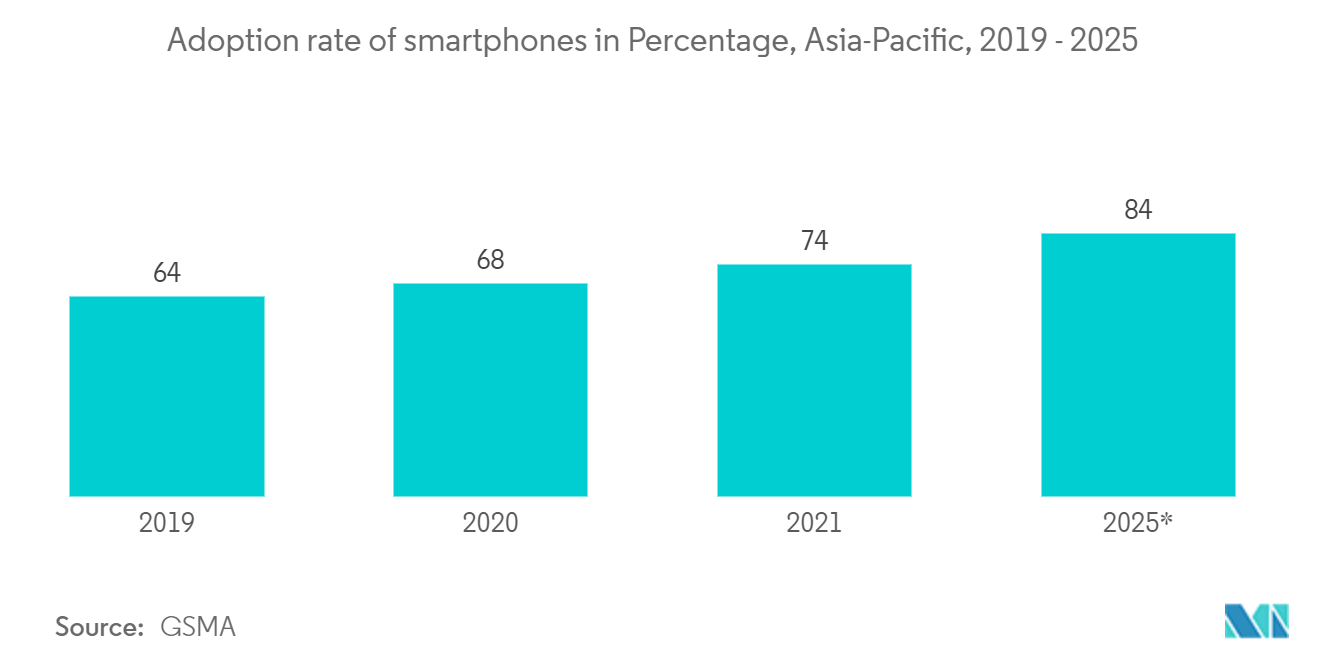
China is expected to hold a significant share
- The sensor market in China is growing extremely quickly, and a rapidly rising community of producers is providing the country with a high volume of sensors for physical and chemical variables. One of the largest consumers of sensors, the automobile industry supports China's micro-electromechanical system industry.
- Additionally, according to CAAM, in April 2022, around 210,000 commercial vehicles and 996,000 passenger cars were produced in China. This will drive the market growth for sensors in the forecast period.
- China has emerged as the market leader for image sensors among the Asia-Pacific nations because of its expanding economy and growing proportion of the global electronics industry. In addition to having a sizable domestic market, China is exporting an increasing number of smartphones with cameras to other countries.
- Panasonic, Sharp, Canon, Himax Technologies, Hamamatsu Photonics K.K., Samsung, and Semiconductor Components Industries are some of the top companies competing in China's CMOS image sensor market.
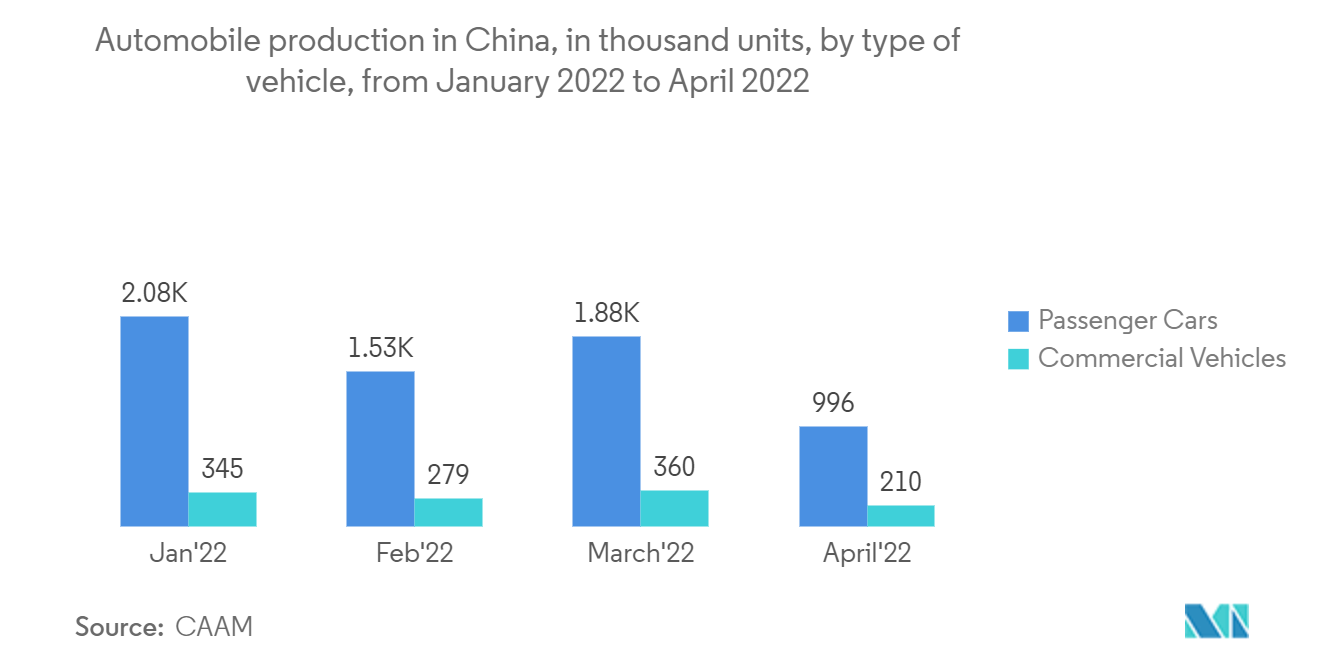
Asia-Pacific Sensors Industry Overview
The Asia-Pacific sensor market is fragmented and highly competitive. Some key players are Texas Instruments Incorporated, Omron Corporation, Honeywell International Inc., Omega Engineering Inc., etc. These players are continuously innovating new products to stay ahead of the competition.
In November 2022, the KD6R1064CXF-NL model of the new KD-CXF series of contact image sensors (CISs) from Mitsubishi Electric Corporation boasted the widest field depth in the industry. CISs are often used in production to check product surfaces for blemishes, filth, incorrect label coloration or placement, etc.
In June 2022, Sony Group announced its plan to enhance its image sensor technology to expand its product portfolio and strengthen its market position. The company had been investing in its R&D capabilities to provide its customers with a solution for focusing on multiple targets when taking a picture via a smartphone. Such infinitives by the companies in the market are expected to increase the demand for sensors in a smartphone, thereby fueling the demand growth for sensors in the Asia-Pacific region.
Asia-Pacific Sensors Market Leaders
-
Texas Instruments Incorporated
-
Omega Engineering Inc.
-
Honeywell International Inc.
-
Rockwell Automation Inc.
-
Omron Corporation
*Disclaimer: Major Players sorted in no particular order
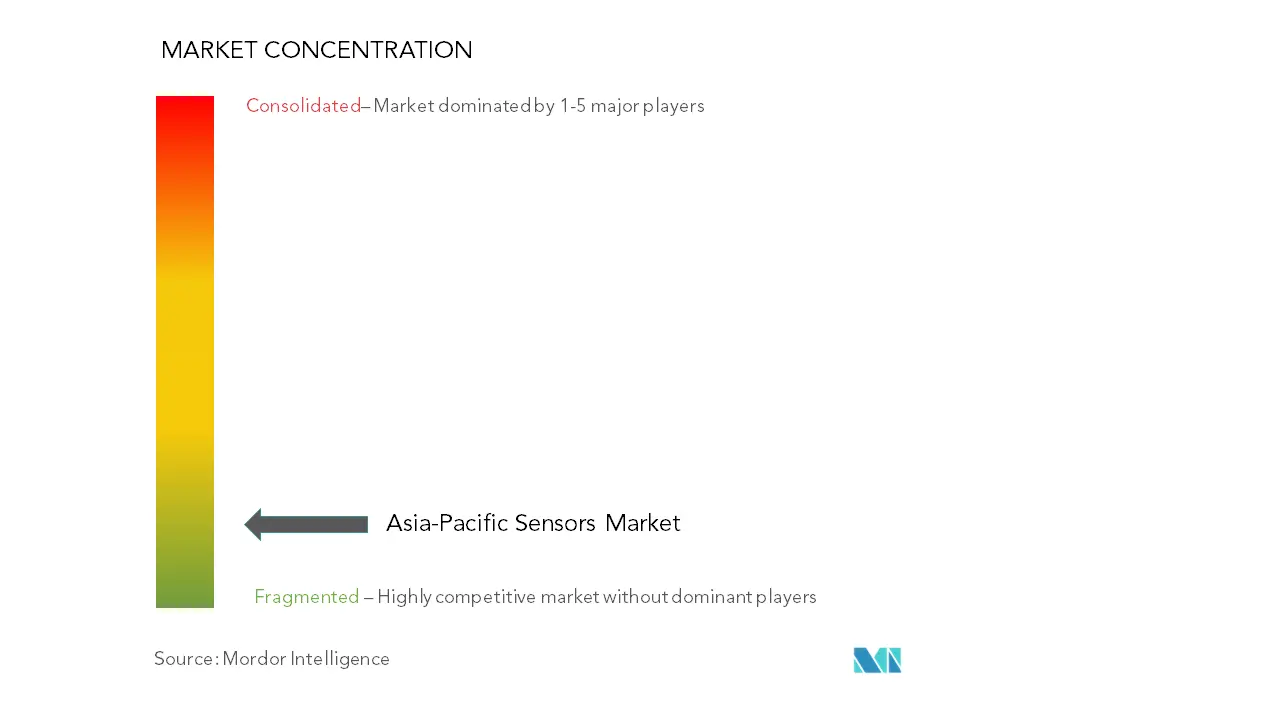
Asia-Pacific Sensors Market News
- February 2023: The government of Jammu and Kashmir approved an INR 30.40 crore project, "Sensor-based Smart Agriculture," envisaging the integration of agriculture with technology driven by artificial insemination and IoT for automation of practices, enhanced resource use efficiency, and profitability. The project would enable the use of high-tech polyhouses for the cultivation of cash crops throughout the year with the application of IoT and automation for monitoring the microclimatic parameters of plants.
- May 2022: Panasonic i-PRO Sensing Solutions Co., Ltd. announced the introduction of its new multi-sensor camera range with deep learning intelligence at the edge in APAC and the launch of a new product portfolio under the brand name "i-PRO" in the APAC market.
Table of Contents
1. INTRODUCTION
- 1.1 Study Assumptions & Market Definition
- 1.2 Scope of the Study
2. RESEARCH METHODOLOGY
3. EXECUTIVE SUMMARY
4. MARKET INSIGHTS
- 4.1 Market Overview
-
4.2 Industry Attractiveness - Porter's Five Forces Analysis
- 4.2.1 Bargaining Power of Suppliers
- 4.2.2 Bargaining Power of Buyers
- 4.2.3 Threat of New Entrants
- 4.2.4 Threat of Substitutes
- 4.2.5 Degree of Competition
- 4.3 Industry Value Chain/Supply Chain Analysis
- 4.4 Macroeconomic Factors Affecting the Industry
5. MARKET DYNAMICS
-
5.1 Market Drivers
- 5.1.1 Emergence of Automation And Industry 4.0
- 5.1.2 Rapid Growth in the Consumer Electronics Industry
-
5.2 Market Restraints
- 5.2.1 High Initial Costs Involved
6. MARKET SEGMENTATION
-
6.1 By Parameters Measured
- 6.1.1 Temperature
- 6.1.2 Pressure
- 6.1.3 Level
- 6.1.4 Flow
- 6.1.5 Proximity
- 6.1.6 Environmental
- 6.1.7 Chemical
- 6.1.8 Inertial
- 6.1.9 Magnetic
- 6.1.10 Vibration
- 6.1.11 Other Parameters Measured
-
6.2 By Mode of Operation
- 6.2.1 Optical
- 6.2.2 Electrical Resistance
- 6.2.3 Biosensors
- 6.2.4 Piezoresistive
- 6.2.5 Image
- 6.2.6 Capacitive
- 6.2.7 Piezoelectric
- 6.2.8 Lidar
- 6.2.9 Radar
- 6.2.10 Other Modes of Operation
-
6.3 By End-User Industry
- 6.3.1 Automotive
- 6.3.2 Consumer Electronics
- 6.3.2.1 Smartphones
- 6.3.2.2 Tablets, Laptops, and Computers
- 6.3.2.3 Wearable Devices
- 6.3.2.4 Smart Appliances or Devices
- 6.3.2.5 Other Consumer Electronics
- 6.3.3 Energy
- 6.3.4 Industrial And Other
- 6.3.5 Medical And Wellness
- 6.3.6 Construction, Agriculture, And Mining
- 6.3.7 Aerospace
- 6.3.8 Defense
-
6.4 By Country
- 6.4.1 China
- 6.4.2 India
- 6.4.3 Japan
- 6.4.4 Rest of APAC
7. COMPETITIVE LANDSCAPE
-
7.1 Company Profiles
- 7.1.1 Texas Instruments Incorporated
- 7.1.2 Omega Engineering Inc.
- 7.1.3 Honeywell International Inc.
- 7.1.4 Rockwell Automation Inc.
- 7.1.5 Omron Corporation
- 7.1.6 Bosch Sensortec Gmbh (Robert Bosch Stiftung GMBH)
- 7.1.7 Infineon Technologies AG
- 7.1.8 NXP Semiconductors Nv
- 7.1.9 Stmicroelectronics NV
- 7.1.10 Ams-osram AG
- *List Not Exhaustive
8. INVESTMENT ANALYSIS
9. FUTURE OF THE MARKET
** Subject To AvailablityAsia-Pacific Sensors Industry Segmentation
A sensor is an instrument that notices changes in the environment and reacts to an output from another system. A sensor transforms a physical phenomenon into a quantifiable analog voltage (or occasionally a digital signal), which is then displayed in a way that can be read by humans or transferred for reading or other processing. The microphone, which transforms sound energy into an electrical signal that may be amplified, transferred, recorded, and repeated, is one of the best-known sensors.
The Asia-Pacific sensors market is segmented by parameters measured (temperature, pressure, level, flow, proximity, environmental, chemical, inertial, magnetic, vibration), by mode of operation (optical, electrical resistance, biosensors, piezoresistive, image, capacitive, piezoelectric, lidar, radar), by end-user industry (automotive, consumer electronics (smartphones, tablets, laptops, and computers), wearable devices, smart appliances or devices), energy, industrial and other, medical and wellness, construction, agriculture, mining, aerospace, and defense), and by country. The market sizes and forecasts are provided in terms of value in USD billion for all the above segments.
| By Parameters Measured | Temperature | |
| Pressure | ||
| Level | ||
| Flow | ||
| Proximity | ||
| Environmental | ||
| Chemical | ||
| Inertial | ||
| Magnetic | ||
| Vibration | ||
| Other Parameters Measured | ||
| By Mode of Operation | Optical | |
| Electrical Resistance | ||
| Biosensors | ||
| Piezoresistive | ||
| Image | ||
| Capacitive | ||
| Piezoelectric | ||
| Lidar | ||
| Radar | ||
| Other Modes of Operation | ||
| By End-User Industry | Automotive | |
| Consumer Electronics | Smartphones | |
| Tablets, Laptops, and Computers | ||
| Wearable Devices | ||
| Smart Appliances or Devices | ||
| Other Consumer Electronics | ||
| Energy | ||
| Industrial And Other | ||
| Medical And Wellness | ||
| Construction, Agriculture, And Mining | ||
| Aerospace | ||
| Defense | ||
| By Country | China | |
| India | ||
| Japan | ||
| Rest of APAC |
Frequently Asked Questions
What is the current Asia-Pacific Sensors Market size?
The Asia-Pacific Sensors Market is projected to register a CAGR of 8.41% during the forecast period (2024-2029)
Who are the key players in Asia-Pacific Sensors Market?
Texas Instruments Incorporated, Omega Engineering Inc., Honeywell International Inc., Rockwell Automation Inc. and Omron Corporation are the major companies operating in the Asia-Pacific Sensors Market.
What years does this Asia-Pacific Sensors Market cover?
The report covers the Asia-Pacific Sensors Market historical market size for years: 2019, 2020, 2021, 2022 and 2023. The report also forecasts the Asia-Pacific Sensors Market size for years: 2024, 2025, 2026, 2027, 2028 and 2029.
Asia-Pacific Sensors Industry Report
Statistics for the 2024 Asia-Pacific Sensors market share, size and revenue growth rate, created by Mordor Intelligence™ Industry Reports. Asia-Pacific Sensors analysis includes a market forecast outlook to for 2024 to 2029) and historical overview. Get a sample of this industry analysis as a free report PDF download.



